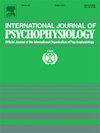行为抑制与静息脑电图的关系:一项神经电生理学研究。
IF 2.5
3区 心理学
Q3 NEUROSCIENCES
引用次数: 0
摘要
研究行为抑制的神经生理指标至关重要;然而,尽管对行为抑制与静息状态脑电图(rs-EEG)之间的关系进行了大量研究,但研究结果并不一致。此外,这些研究主要集中在反应性抑制上,而忽视了有意抑制。因此,本研究旨在重新评估反应性抑制与rs-EEG指标之间的相关性,同时探索有意抑制与rs-EEG之间的关系。采用功率谱分析和微观状态分析对95名被试进行rs-EEG提取,并采用自由二选奇球任务对95名被试进行反应性抑制和故意抑制的评估。结果显示,反应性抑制与rs-EEG指标之间无显著相关性。而有意抑制与δ和β波段的相对功率呈负相关,与α波段的相对功率呈正相关。有意抑制与微状态a的发生率和贡献呈负相关,与微状态d的持续时间呈正相关,与微状态a与C的过渡概率呈负相关,与微状态C与d的过渡概率呈正相关。回归分析显示,微状态a的发生率对有意抑制具有负向预测作用。总的来说,本研究通过填补rs-EEG对故意抑制证据的空白,同时为其评估提供潜在的神经心理学指标,推进了该领域的理论认识和实证研究。本文章由计算机程序翻译,如有差异,请以英文原文为准。
The relationship between behavioral inhibition and resting electroencephalography: A neuroelectrophysiological study
Investigating the neurophysiological indicators of behavioral inhibition is crucial; however, despite numerous studies on the relationship between behavioral inhibition and resting-state electroencephalography (rs-EEG), the findings have yielded inconsistent results. Furthermore, these investigations primarily focused on reactive inhibition while neglecting intentional inhibition. Therefore, this study aimed to reassess the correlation between reactive inhibition and rs-EEG metrics while also exploring the association between intentional inhibition and rs-EEG. Power spectrum analysis and microstate analysis were employed to extract rs-EEG, whereas the Free Two-Choice Oddball task was utilized for assessing both reactive and intentional inhibition among 95 participants. The results revealed no significant correlations between reactive inhibition and rs-EEG metrics. However, intentional inhibition exhibited a negative correlation with relative power in delta and beta bands but a positive correlation with relative power in alpha band. Moreover, intentional inhibition demonstrated a negative correlation with occurrence rate and contribution of microstate A but a positive correlation with duration of microstate D. Additionally, it displayed a negative relationship with the transition probability between microstate A and C but a positive relationship with the transition probability between microstate C and D. The regression analysis revealed that the occurrence rate of microstate A can negatively predict intentional inhibition. Overall, this study advances theoretical understanding as well as empirical research in this field by addressing gaps in rs-EEG evidence for intentional inhibition while providing potential neuropsychological indicators for its assessment.
求助全文
通过发布文献求助,成功后即可免费获取论文全文。
去求助
来源期刊
CiteScore
5.40
自引率
10.00%
发文量
177
审稿时长
3-8 weeks
期刊介绍:
The International Journal of Psychophysiology is the official journal of the International Organization of Psychophysiology, and provides a respected forum for the publication of high quality original contributions on all aspects of psychophysiology. The journal is interdisciplinary and aims to integrate the neurosciences and behavioral sciences. Empirical, theoretical, and review articles are encouraged in the following areas:
• Cerebral psychophysiology: including functional brain mapping and neuroimaging with Event-Related Potentials (ERPs), Positron Emission Tomography (PET), Functional Magnetic Resonance Imaging (fMRI) and Electroencephalographic studies.
• Autonomic functions: including bilateral electrodermal activity, pupillometry and blood volume changes.
• Cardiovascular Psychophysiology:including studies of blood pressure, cardiac functioning and respiration.
• Somatic psychophysiology: including muscle activity, eye movements and eye blinks.

 求助内容:
求助内容: 应助结果提醒方式:
应助结果提醒方式:


